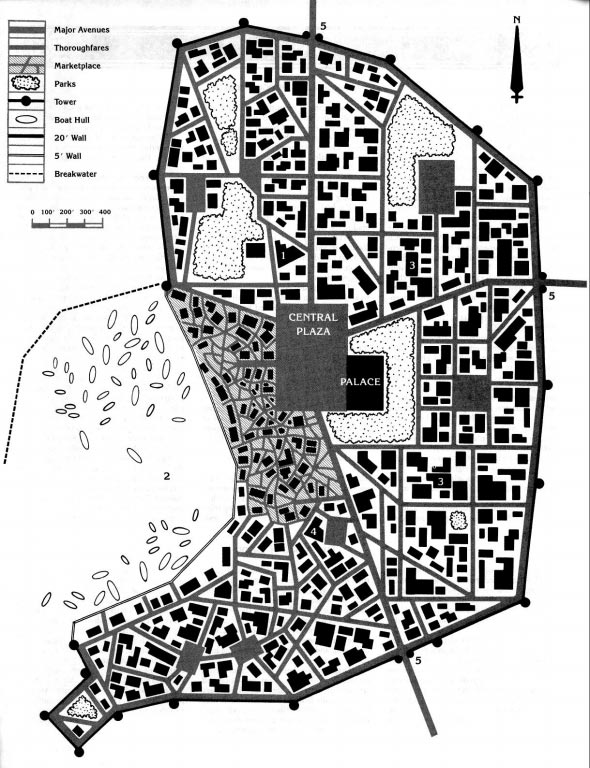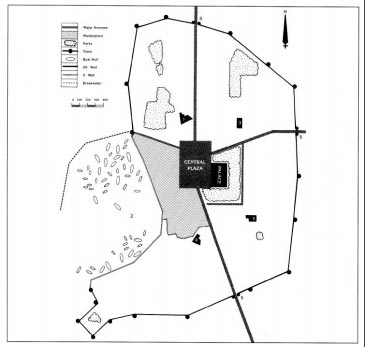Let's talk about when #Dragonlance became Dragonlance Classics.
By 1990, the original DL modules were out of print and a new edition of Advanced D&D had been released.
DL is still insanely popular, but reprinting all 14 modules would be expensive + risky.
So what do you do?

By 1990, the original DL modules were out of print and a new edition of Advanced D&D had been released.
DL is still insanely popular, but reprinting all 14 modules would be expensive + risky.
So what do you do?


tl;dr You package them up into three reprint volumes, with 4 modules in each volume.
...
Hang on, though. 3 volumes x 4 modules = 12 modules.
The original Dragonlance Saga was 14 modules.
That doesn't add up.
...
Hang on, though. 3 volumes x 4 modules = 12 modules.
The original Dragonlance Saga was 14 modules.
That doesn't add up.
We're continuing our Let's Read of the Dragonlance Saga. If you'd like to begin at the beginning, you'll find that over here:
https://twitter.com/hexcrawl/status/1528081088001605634
tl;dr The Classics reprints (printed under the DLC module code) didn't include two of the original modules.
DL5 has been a (very inadequate) setting gazetteer for Dragonlance.
The 130-page Dragonlance Adventures had been published in 1987, so DL5 was obsolete.

The 130-page Dragonlance Adventures had been published in 1987, so DL5 was obsolete.


DL11 Dragons of Glory was actually a full-blown hex-and-chit wargame.
It was ostensibly designed to integrate with the rest of the series, but... didn't. So it was superfluous.

It was ostensibly designed to integrate with the rest of the series, but... didn't. So it was superfluous.


The key thing to understand about the DLC reprints is this:
It makes me angry how incredibly bad they are.
Here's an easy example: On the left is the map of Tarsis from DL6. On the right is the map of Tarsis from DLC2.
Notice anything missing? Oh! Right! ALL THE BUILDINGS!

It makes me angry how incredibly bad they are.
Here's an easy example: On the left is the map of Tarsis from DL6. On the right is the map of Tarsis from DLC2.
Notice anything missing? Oh! Right! ALL THE BUILDINGS!


The DLC modules are consistently crippled by this sort of thing. There are, in fact, essential maps which are entirely missing from the DLC volumes!
Just keyed locations with no map to reference for them.
Just keyed locations with no map to reference for them.
I feel this quite personally, because when I was a kid in '90 or '91 and picked up a copy of DLC1, I was completely baffled.
I literally could not figure out how to run the adventures because of how badly the reprints were done.
I literally could not figure out how to run the adventures because of how badly the reprints were done.
Here's another egregious example.
At the end of DL1 one of the PCs is assumed to strike a dragon with the blue crystal staff. When they do so, the dragon is slain, but the PC also vanishes in an explosion of light; seemingly killed while sacrificing themselves.
At the end of DL1 one of the PCs is assumed to strike a dragon with the blue crystal staff. When they do so, the dragon is slain, but the PC also vanishes in an explosion of light; seemingly killed while sacrificing themselves.

Crucially, there is an Epilogue in which the PCs return to the entrance of the dungeon, they find their not-so-dead comrade still alive, and then there's a transition to DL2. 

But if you're reading this module in the DLC1 reprint, guess what they forget to include?
The entire DL1 epilogue.
The entire DL1 epilogue.
To dive deeper into this, we need to talk about the presentation of the DL adventures.
Most of the DL modules are broken down into EVENTS (which are usually time-based) and ENCOUNTERS (which are usually keyed to a map).
Most of the DL modules are broken down into EVENTS (which are usually time-based) and ENCOUNTERS (which are usually keyed to a map).
So DL1, for example, has an Event track which consists of:
1. The Adventure Begins
2. Goldmoon Found
3. Goldmoon Seen Again
4. Reading of the Canticle
5. All Winds Turn Cold
6. Thunderclouds
7. The Dragonarmies March
1. The Adventure Begins
2. Goldmoon Found
3. Goldmoon Seen Again
4. Reading of the Canticle
5. All Winds Turn Cold
6. Thunderclouds
7. The Dragonarmies March
These range from "Thunderclouds," which consists entirely of:
"During the fifth game day, thunderclouds hover angrily to the west, south, and north of the party."
"During the fifth game day, thunderclouds hover angrily to the west, south, and north of the party."
To "The Dragonarmies March" which is a complex, multi-day sequence in which the dragonarmies gobble up regions of the map.
As first glance, this looks like a hexcrawl.
But if you take a closer look, you'll notice that the map is actually broken up into regions using thin black lines. It's these REGIONS which are actually keyed.
But if you take a closer look, you'll notice that the map is actually broken up into regions using thin black lines. It's these REGIONS which are actually keyed.

For example, all of 33 is keyed as the Kiri Valley:
The forest darkens and thickens beside an ancient trail. A cold, dry stillness hovers in the air, and the trees are knotted and bent. Everything seems to watch you.
An evil wizard died here long ago. Only his essence remains.
The forest darkens and thickens beside an ancient trail. A cold, dry stillness hovers in the air, and the trees are knotted and bent. Everything seems to watch you.
An evil wizard died here long ago. Only his essence remains.
I've done a much deeper look at how this map, and other hex maps in the #Dragonlance Saga, work over at the Alexandrian.
thealexandrian.net/wordpress/4800…
thealexandrian.net/wordpress/4800…
The key thing is that all of the Events in a single module run from 1 to X. And then all of the Encounters run from 1 to X.
So in an adventure with multiple parts/locations, everything is just jammed together.
So in an adventure with multiple parts/locations, everything is just jammed together.
So if you're reading through the Encounters in an adventure, one entry will be on a hex map and then the next will be on a region map. And a little later you'll swap to a dungeon.
This can already be moderately disorienting/confusing in some of the DL adventures.
But the DLC modules take it one step further: Because the numbers run indiscriminately from 1 to X, the DLC reprints decide to make the practice "consistent" by renumbering the keyed encounters for the entire reprint.
So in DLC1, which reprints DL1 thru DL4, the numbers in DL1 match the original module (1-70). but DL2 which was originally 1-73 is now 71-143. And so forth.
Which makes a certain amount of sense.
EXCEPT...
Which makes a certain amount of sense.
EXCEPT...
...they sometimes failed to update the numbers on the maps.
Which is not only wrong (rendering the maps nigh unusable), but also means you have a huge string of undistinguished encounter keys with numbers that appear on multiple maps in the module.
It's incomprehensible.
Which is not only wrong (rendering the maps nigh unusable), but also means you have a huge string of undistinguished encounter keys with numbers that appear on multiple maps in the module.
It's incomprehensible.
... and they FREQUENTLY (particularly in DLC2 and DLC3) update the headings without updating the cross-references.
Here's an example that's both hilariously obvious and relatively easy to figure out.
Here's an example that's both hilariously obvious and relatively easy to figure out.

Obviously 108A, 108B, and 108C were originally 25A, 25B, and 25C. Someone did manage to change 25B to 258 (for some reason).
Still, you can puzzle this one out readily enough. But the actual cross-references ("go to Encounter 43" or "Encounters 25-48 are located in the dungeon") are, once again, incomprehensible.
It's not so bad when they're obviously wrong. Painful when it's not.
It's not so bad when they're obviously wrong. Painful when it's not.
Not all of these problems can be laid at the feet of the DLC reprints, though.
The beginning of DL2 Dragons of Flame, for example, is fascinating. It's like someone took an adventure, threw it in a blender, and then published what poured out.
The beginning of DL2 Dragons of Flame, for example, is fascinating. It's like someone took an adventure, threw it in a blender, and then published what poured out.

To start at the very beginning: "Start the characters at the spot marked 'X' on the area map. They are moving westward on a cloud, chill afternoon."
But there is no X on the map.
But there is no X on the map.

The DLC1 reprint corrects this error, but:
(a) includes MULTIPLE region maps with X's on them and doesn't specify which one; and
(b) if you recall, cuts the epilogue that explains how the characters got here from the dungeon they were just in.
BID.
(a) includes MULTIPLE region maps with X's on them and doesn't specify which one; and
(b) if you recall, cuts the epilogue that explains how the characters got here from the dungeon they were just in.
BID.
The first half of DL2 consists of a string of numbered events.
These events are triggered in different ways: Some are triggered by time. Some are triggered when the PCs get to specific locations on the map. Others be broad conditionals ("when the party is in open terrain").
These events are triggered in different ways: Some are triggered by time. Some are triggered when the PCs get to specific locations on the map. Others be broad conditionals ("when the party is in open terrain").

But the triggers are buried in the text, sometimes multiple paragraphs deep.
It's difficult to really communicate how disorienting this is. Very much like taking a story, randomly shuffling the pages, and then trying to figure out what order they go in.
Except moreso.
It's difficult to really communicate how disorienting this is. Very much like taking a story, randomly shuffling the pages, and then trying to figure out what order they go in.
Except moreso.
On top of this, some of the encounters are are just arbitrarily split across multiple numbers. For example, encounters 6-8 are actually just one encounter. #6 helpfully tells you to proceed to encounter #7, but #7 doesn't do the same thing for #8.
You have to REALLY work to figure out how any of this is supposed to work during play (or to use it while running the game).
And once you do figure it out, the result is... lackluster.
tl;dr The PCs need to be arrested and shipped to a prison so they can arrange a prison break.
tl;dr The PCs need to be arrested and shipped to a prison so they can arrange a prison break.
• • •
Missing some Tweet in this thread? You can try to
force a refresh











